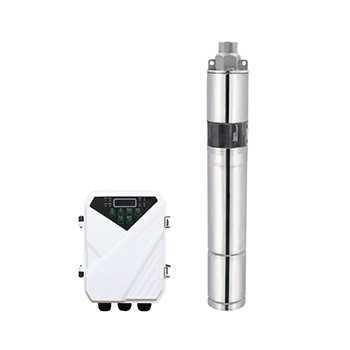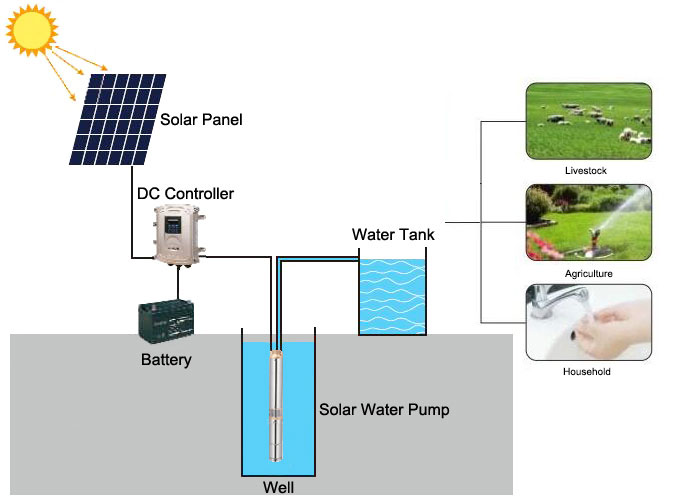In the context of global sustainable development, solar energy, as a clean and renewable resource, is gradually penetrating various energy supply systems. Solar water pump systems, as a prime example of photovoltaic technology application, demonstrate significant potential and value in areas such as agricultural irrigation, livestock water supply, and household water usage, due to their efficient, environmentally friendly, and self-sufficient characteristics. This article aims to provide a comprehensive analysis of the technical principles, detailed classification, broad applications, and future development trends of solar water pumps, serving as a reference for research and application in related fields.
What is a Solar Water Pump?
A solar water pump system, also known as a photovoltaic water pumping system, is a device that directly converts solar energy into mechanical energy to drive water pumps for lifting and transporting water. The system mainly consists of core components such as photovoltaic arrays (solar panels), solar inverters, water pumps, and control units, forming a closed-loop energy conversion and utilization system. Under adequate sunlight conditions, the photovoltaic array continuously generates electricity, which is converted by the inverter into alternating current (AC) or direct current (DC) suitable for the water pump, driving the pump to operate and achieve the purpose of lifting and transporting water from low to high or over long distances.

Classification of Solar Water Pumps
Solar water pumps can be classified into various types based on installation location and functional characteristics. The main classification methods are as follows:
By Installation Location
- Surface Pumps: Commonly used in large irrigation systems or farms, they transport water from sources such as lakes or rivers to fields through long-distance pipelines. Surface pumps are simple in design, easy to maintain, and suitable for high flow, low head irrigation needs.
- Submersible Pumps: Installed directly at the bottom of wells or deep in water bodies, these pumps are connected to the photovoltaic array on the surface through cables. Submersible pumps are characterized by their small size, high efficiency, and large head, making them ideal for deep-well water extraction or high-head applications.
By Working Method
- DC Pumps: Driven directly by the direct current generated by the photovoltaic array, eliminating the need for an inverter and simplifying the system structure. However, they are limited by the output voltage and current range of the photovoltaic array.
- AC Pumps: Operated by converting the direct current from the photovoltaic array into alternating current through an inverter, allowing them to adapt to a wider range of pump models and working conditions. However, the system complexity is relatively higher.
By Application
- Agricultural Irrigation Pumps: Designed to meet the needs of farmland irrigation, focusing on balancing flow and head to achieve efficient water-saving irrigation.
- Domestic Water Pumps: Provide drinking water or household water for families, communities, or small villages, with high requirements for water quality and supply stability.
- Industrial Water Pumps: Used in scenarios such as water circulation and cooling in industrial production processes, demanding higher performance, durability, and automated control of the pumps.
How Does a Solar Water Pump Work?
The working principle of solar water pumps is based on the photovoltaic effect, where solar panels generate a potential difference under sunlight, converting light energy into electrical energy. This process produces direct current, which is converted by the solar pump inverter (if using AC pumps) into the current suitable for the water pump. This current then drives the motor inside the pump, which in turn drives the impeller or piston to move, achieving the lifting and transportation of water.
To enhance system efficiency, solar water pump systems are often equipped with Maximum Power Point Tracking (MPPT) technology, which can monitor the output power of the photovoltaic array in real time and automatically adjust the operating point to near the maximum power point, ensuring maximum utilization of solar energy even when sunlight conditions change. Additionally, intelligent control units allow the system to adjust the pump's operating status based on actual demand, achieving energy savings and reducing consumption.
Wide Applications of Solar Water Pumps
- Livestock Irrigation: In vast pastures, solar water pumps provide a stable water source for livestock. By laying pipelines or installing portable systems, water sources can be flexibly introduced to various parts of the pasture, reducing transportation costs and improving irrigation efficiency. The advantages of solar water pumps are particularly evident in remote areas where the electricity supply is inconvenient.
- Agricultural Irrigation: Solar water pumps are widely used in small farms, orchards, vineyards, and other places. They not only solve the power dependency problem in traditional irrigation methods but also improve water resource utilization efficiency through precision irrigation technology, promoting the sustainable development of agricultural production.
- Household Water Supply: In remote rural or isolated areas, solar water pumps have become an important solution for household water supply. They provide clean and safe drinking water for residents, reduce reliance on traditional energy sources and lower living costs. Moreover, solar water pumps can be used in conjunction with water storage tanks, filters, and other equipment to build a complete household water supply system.
- Emergency Water Supply and Disaster Relief: In natural disasters or emergencies, solar water pumps can be quickly deployed and put into use to provide the affected areas with urgently needed drinking and irrigation water. Their ability to operate independently without external power makes them a vital part of emergency water supply systems.

With continuous advancements in solar technology and ongoing cost reductions, the application prospects of solar water pump systems will become even broader. In the future, solar water pumps will develop towards higher efficiency, greater intelligence, and better environmental friendliness. On one hand, optimizing the conversion efficiency of photovoltaic arrays, enhancing the performance and stability of inverters, and developing more advanced water pump technologies can further improve the overall efficiency and reliability of the system. On the other hand, leveraging modern information technology means such as the Internet of Things (IoT) and big data can achieve remote monitoring, intelligent dispatching, and fault warning for solar water pump systems, further enhancing their operation and maintenance efficiency and user experience.
Inverter.com offers solar water pumps ranging from 80W to 1500W, dedicated to providing innovative, resource-saving, and environmentally friendly solutions for agriculture, irrigation, desert control, urban water features, and home use. If needed, please feel free to contact us.
In summary, as a perfect combination of solar technology and traditional pump technology, solar water pump systems have broad development prospects and significant social significance. With continuous technological progress and market maturation, solar water pumps will play an increasingly important role in various fields, contributing to global energy transition and sustainable development goals.
